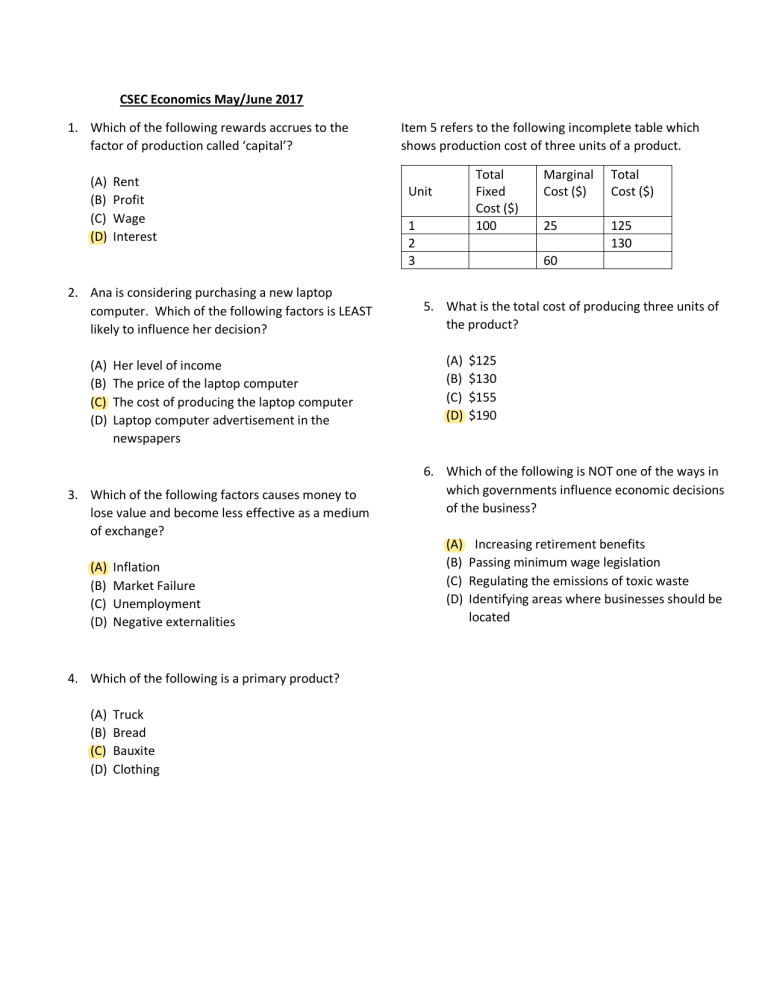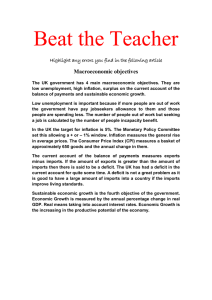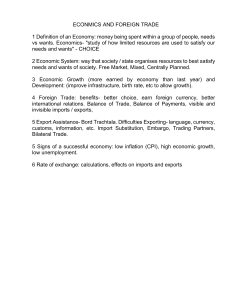
CSEC Economics May/June 2017 1. Which of the following rewards accrues to the factor of production called ‘capital’? (A) (B) (C) (D) Rent Profit Wage Interest 2. Ana is considering purchasing a new laptop computer. Which of the following factors is LEAST likely to influence her decision? (A) (B) (C) (D) Her level of income The price of the laptop computer The cost of producing the laptop computer Laptop computer advertisement in the newspapers 3. Which of the following factors causes money to lose value and become less effective as a medium of exchange? (A) (B) (C) (D) Inflation Market Failure Unemployment Negative externalities 4. Which of the following is a primary product? (A) (B) (C) (D) Truck Bread Bauxite Clothing Item 5 refers to the following incomplete table which shows production cost of three units of a product. Total Fixed Cost ($) 100 Unit 1 2 3 Marginal Cost ($) Total Cost ($) 25 125 130 60 5. What is the total cost of producing three units of the product? (A) (B) (C) (D) $125 $130 $155 $190 6. Which of the following is NOT one of the ways in which governments influence economic decisions of the business? (A) (B) (C) (D) Increasing retirement benefits Passing minimum wage legislation Regulating the emissions of toxic waste Identifying areas where businesses should be located Item 7 refers to the following diagram which illustrates the production possibility frontier for an economy that is capable of producing bauxite and sugar in different combinations. 9. An outward shift in a production possibility curve can be caused by an (A) (B) (C) (D) Increase in wages Increase in prices Increase in imports Improvement in technology Sugar 10. ABC Ltd. Purchases raw cotton and produces fabric. XYZ Ltd. buys fabric from ABC Ltd. and makes T-shirts which it markets directly to clothing stores. In which sector of economic activities are both firms engaged? x Bauxite 7. Point X on the graph represents (A) (B) (C) (D) Economic growth Unemployed resources An efficient combination An unattainable combination 8. A normal supply curve for farm produce will slope upwards, from left to right, if farmers (A) (B) (C) (D) Pass on increased cost to consumers Are willing to produce more as prices increase Increase their profit margins as prices increase Are willing to increase supply as demand increase (A) (B) (C) (D) Tertiary Primary Quaternary Secondary 11. An advantage of a planned economic system is that (A) there is usually a more equitable distribution of wealth (B) firms have greater incentive to produce (C) workers are more motivated and diligent (D) consumers have a wider variety of goods 12. The MAIN objective of a credit union is to (A) (B) (C) (D) Provide scholarships to students Encourage thrift among its members Provide credit to government agencies Provide investment funds for companies 13. Country X has a very low unemployment rate as most of its citizens work overseas for 6-8 months during the year. This type of unemployment can be classified as (A) (B) (C) (D) Cyclical Real wage Seasonal Structural (A) (B) (C) (D) Profit earned by farmers Reduction of manufacturing Wages earned by farmers Rent for the land on which crops are grown 17. A government reduces taxes on carrots. This causes the price for carrots to fall by 50%. The price elasticity of demand for carrots in this case is 14. Prices of goods in market economies fluctuate while prices for goods in planned economies tend to be fixed. The MOST likely reason for this difference is that in the market economy, (A) (B) (C) (D) 16. The government of Country X decides to switch resources from manufacturing to crop production. The opportunity cost of this decision is the Profits are lower Producers are never efficient There are higher employment levels Demand and supply forces determine prices (A) (B) (C) (D) 0 0.4 -1 2.5 Item 18 refers to the following curves which shows the demand for some products. 15. Item 15 refers to the following diagram which illustrates the production possibility frontier for an economy in Year 1 (AA) and Year 2 (BB). Capital goods I II A B X B A Consumer goods 15. From the diagram below, it can be deduced that (A) point X was unattainable in Year 2 (B) point X was efficient in Year 1 and Year 2 (C) There was decreasing opportunity cost in Year 1 and Year 2 (D) there was economic growth between Year 1 and Year 2 III IV 18. Which of the curves above indicates that demand for the product is perfectly elastic? (A) (B) (C) (D) I II III IV 19. Which of the following is NOT an example of a factor of production in a commercial bank? (A) (B) (C) (D) The building The bank’s vault Shareholders of the bank Special savings accounts for students 20. Shinelle spends 0.02% of her monthly income on a particular good. Her demand for this good, in terms of price, can be described as (A) (B) (C) (D) Elastic Inelastic Perfectly elastic Perfectly inelastic 21. Open competition on a world wide scale facilitates (A) (B) (C) (D) High level of dependence on tourism Increases in trade unions’ negotiating power Government manipulation of market outcomes The development of comparative advantage 24. Which of the following is TRUE about the financial institutions? (A) They provide insurance protection to speculators (B) They are free from government interference (C) They place emphasis on consumer education and national development (D) They channel funds from those who have saved to those who wish to borrow 25. A pure public good can be described as (A) (B) (C) (D) Excludable Zero-priced Diminishable Complimentary 26. Which of the following is usually a consequence of widespread retrenchment in a country? (A) (B) (C) (D) Reduction in crime rate Increase standard of living A fall in the standard of living Equality in income distribution 22. The term ‘money supply’ refers to the (A) The total stock of money in an economy at any moment (B) Amount of money traded in the foreign exchange market (C) Total assets base of the institutions in the financial sector (D) Total amount of gold, silver and other precious metals in the reserve 23. The organization responsible for the regulation and control of the financial sector is the (A) (B) (C) (D) Treasury Central Bank Board of Currency Control Institute of Monetary Affairs 27. Globalization may be MOST accurately defined as the (A) Movement of technology and financial markets worldwide (B) Movement of tangible and intangible goods among countries (C) International trade of goods and services including skilled workers (D) Integration of financial services, technology, and commodity markets worldwide 28. Which of the following is LEAST likely to occur when there is market failure? (A) A decline in social welfare (B) An increase in poverty through the country (C) An increase in the level of unemployment among skilled and unskilled labour (D) An adequate amount of goods and services for consumers 29. Governments often put measures in place to control monopolies because monopolies (A) (B) (C) (D) 31. Line X represents payment (A) (B) (C) (D) Goods taken on credit To the factor of production Of taxes to the government To the financial institutions for loans Item 32 refers to the following diagram which shows the price and quantity demanded for Good X. Price S Set fair prices Restrict supply Earn normal profits Promote consumer sovereignty D₁ D 0 Quantity 32. The movement of the demand curve Of Good X from D to D₁ results from an increase in 30. Which of the following best defines the term ‘protectionism’? (A) Restriction of imports into the country (B) Dependency on a primary product for export (C) Free movement of goods and services among countries (D) Establishment of a trade bloc among a group of countries (A) (B) (C) (D) Consumer income The price of good X The price of a complement The cost of inputs used to produce good X Item 33 refers to the following market supply curves. I P II P S S Item 31 refers to the following diagram which shows the circular flow of income. Q Households III P Payment for Goods and Services x Firms Q IV P S S Q (D) Flow of funds into the household sector 33. Which of the following curves shows that price elasticity of supply is unitary. (A) I (A) Government revenue exceeds government borrowing (B) Government revenues are greater than subsidies (C) Government spending equals government revenue (D) Government spending exceeds government revenue (B) II (C) III (D) IV 34. Which of the following is NOT a function of the financial sector? (A) (B) (C) (D) 37. Which of the following statement best describes a fiscal deficit? Providing a safe place for savings Preventing liquidity within the economy Facilitating payments for goods and services Making credit available to households and firms 38. Which of the following is an advantage of a market economic system? (A) (B) (C) (D) There is equality in income It gives choice to consumers It reduce pollution and congestion Price control measures can be effected 35. Which of the following has led to rapid expansion of e-commerce? 39. Which of the following is a positive effect of ‘brain drain’ phenomenon for the country of origin? (A) (B) (C) (D) (A) (B) (C) (D) The emergence of the internet The formation of regional groupings The increase in the levels of income The rise in inflationary pressures Item 36 refers to the following diagram. 40. “Resources, both human and physical, are required to produce goods and services.” Financial Sector Savings Deposit Sese Sustained growth Source of remittances Guaranteed development Discovery of more talent The statement MOST accurately describes Loanable funds for Firms/Households Investment/ Spending 36. The diagram best describes the (A) Functions of the central bank (B) Flow of deposit into the financial sector (C) Role the financial sector performs for customers (A) (B) (C) (D) Productivity Entrepreneurship Factors of production Factors of productivity 41. Country A is experiencing a balance of payment deficit. Which of the following measures would the government MOST likely use to reduce the deficit in the short term? (A) Reduce the volume of exports to other countries (B) Engage in trade with other low-cost producers of goods (C) Increase the importation of goods from other countries (D) Impose restrictions on goods imported from other countries 42. The term recession refers to a period of (A) (B) (C) (D) Increased economic activity Gradual increase of GDP of a country National economic prosperity in a country Temporary economic decline Item 43 refers to the following economic measures. I. II. III. Reducing the bank rate Increasing interest rate Decreasing money supply 43. Which of the measures above can be used to reduce inflation? (A) (B) (C) (D) I and II only I and III only II and III only I, II and III 44. Which of the following is NOT a benefit of economic integration? (A) (B) (C) (D) Higher cost of living Increased productivity Improved competitiveness of products Mutual benefits among member countries 45. Which of the following is a likely DISADVANTAGE of international trade? (A) (B) (C) (D) Economies of scale Improved international relations Increased consumer choice and variety Stiff competition of local industries 46. The terms of trade of country X is 150. This is considered to be (A) (B) (C) (D) Neutral Inadequate Favourable Unfavourable 47. The currency of a country may appreciate in value if (A) (B) (C) (D) The demand for its imports rises The demand for its exports rises Its balance of trade deficit rises Its balance of payment deficit rises 48. The economic system where major economic decisions are made by private individuals and businesses is known as a (A) (B) (C) (D) Free market economy Planned economy Controlled economy Subsistence economy Item 49 refers to the following diagram which shows the price of an item and the quantity demanded and supplied before and after the item is subsidized. S is the supply curve before a subsidy is given. Price S Ss Po P1 51. Which of the following will contribute to a surplus on the balance of trade of a country? (A) The value of exports is greater than the value of imports (B) The value of imports are greater than the value of exports (C) The volume of exports are greater than the volume of imports (D) The volume of imports are greater than the volume of exports D 0 Q0 Q1 Quantity 49. As a result of the granting of the subsidy, it is expected that (A) (B) (C) (D) Supply will increase Supply will decrease Demand will decrease Price will increase 50. A country has a comparative advantage in the production of a commodity when it (A) Can produce more of that commodity than any other country (B) Has a larger share of the market for that commodity than any other country (C) Can produce that commodity at a lower opportunity cost than any other country (D) Accounts for a greater percentage of global sales of that commodity than any other country 52. Which of the following is referred to as the banker’s bank? (A) (B) (C) (D) The World Bank The Central Bank A commercial bank An investment bank 53. Country X is obtained an inflow of $300, 000, 000 in foreign direct investment. IN which section of the balance of payments accounts of Country X, will this be recorded? (A) (B) (C) (D) Capital Visible trade Invisible trade Balance of trade 54. The restrictions on international trade through tariffs, embargoes, quotas, and exchange controls is referred to as (A) (B) (C) (D) Globalization Protectionism A bilateral agreement Structural adjustment 55. The term ‘e-commerce’ refers to (A) (B) (C) (D) Ecotourism Export businesses Electronic businesses Economies of scale 56. Country X allows foreign exchange markets to determine the rate of its domestic currency based on the forces of demand and supply. This type of exchange rate is referred to as (A) (B) (C) (D) Exports Savings Investment Household income 58. The acronym FDI, in economics, means (A) (B) (C) (D) Item Invisible imports Invisible exports Visible imports Visible exports Foreign Direct Income Foreign Direct Investment Fixed Domestic Investment Floating Domestic Investment ($M) 50 80 70 32 59. What is this country’s balance of merchandise trade? Fixed Pegged Floating Managed 57. Which of the following is referred to as a withdrawal from the circular flow of income? (A) (B) (C) (D) Item 59 refers to the following table which shows a country’s current account of its balance of payment for the year 2015. (A) (B) (C) (D) -$38M $20M $38M $48M 60. If a country can produce 20 units of products X or 10 units of product Y, the opportunity cost of 1 unit of a product Y is (A) (B) (C) (D) 0.1 units of product x 1 unit of product x 2 units of product x 2.5 units of product x



